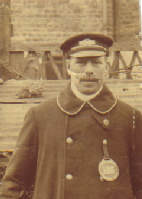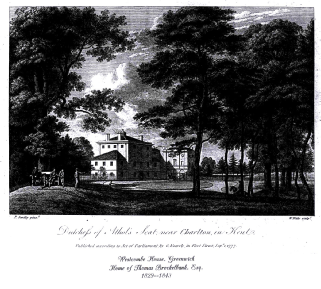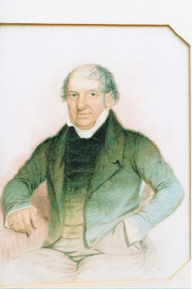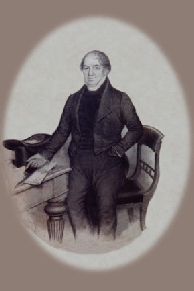

January 2010
Records of Trinity College, Cambridge
An Internet search revealed the following information about the academic careers of Charles Evans Newbon and his younger brother Septimus Baily Newbon among the records of Trinity College, Cambridge, where the two brothers studied. This information tallies with that supplied by Trinity College itself in 2008:
Newbon, Charles Evans. Son of James Sheldon [sic.] Newbon of Elms House, Hammersmith, London. Born March 3, 1839, in London. School, King's College School, London (Dr Major). Pensioner, December 23, 1856. Tutor, Mr Mathison. [Matriculated, 1857; B.A. 1861; M.A. 1864; LL.M. 1864.]
Newbon, Septimus Baily. Son of James Shelton Newbon of The Elms House, Hammersmith, London. Born January 28, 1846, at Blackheath, Kent. Pupil of Monsieur E. R. de Lervarte, Paris. Pensioner, June 25,1864. Tutor, Mr Mathison. [Matriculated, 1865. Did not graduate.]
Society of Genealogists talk: Carriers, Carters, Carmen and Cabmen
Many members of the Newbon family were carmen and this very detailed talk provided much fascinating background to the profession. Particularly interesting was learning that the motorcab arrived in London in 1903, after which many former carmen became omnibus drivers, exactly as Walter Thomas Newbon did.
February 2010
London Transport Museum
An Internet search revealed the following information about the academic careers of Charles Evans Newbon and his younger brother Septimus Baily Newbon among the records of Trinity College, Cambridge, where the two brothers studied. This information tallies with that supplied by Trinity College itself in 2008:
Newbon, Charles Evans. Son of James Sheldon [sic.] Newbon of Elms House, Hammersmith, London. Born March 3, 1839, in London. School, King's College School, London (Dr Major). Pensioner, December 23, 1856. Tutor, Mr Mathison. [Matriculated, 1857; B.A. 1861; M.A. 1864; LL.M. 1864.]
Newbon, Septimus Baily. Son of James Shelton Newbon of The Elms House, Hammersmith, London. Born January 28, 1846, at Blackheath, Kent. Pupil of Monsieur E. R. de Lervarte, Paris. Pensioner, June 25,1864. Tutor, Mr Mathison. [Matriculated, 1865. Did not graduate.]
Society of Genealogists talk: Carriers, Carters, Carmen and Cabmen
Many members of the Newbon family were carmen and this very detailed talk provided much fascinating background to the profession. Particularly interesting was learning that the motorcab arrived in London in 1903, after which many former carmen became omnibus drivers, exactly as Walter Thomas Newbon did.
February 2010
London Transport Museum
In the 1940 edition of ‘Pennyfare’ (London Transport’s staff news publication) the death of Walter Thomas Newbon was noted, after 25 years of service as an omnibus driver at Streatham Garage. Walter can be seen in his omnibus driver’s uniform in this wonderful photograph, probably dating from around 1930.
Spring 2010
‘Edge v. Newbon’: the children of Walter Newbon in the Court of Chancery (documents at TNA)
I have spent a large amount of time this Spring making a full transcript of the documents from this fascinating Chancery case which followed the death of Walter Newbon in 1798 and rumbled on for half a century! The documents can be found at The National Archives (C124/393/1) and comprise 30 separate documents, some including extremely detailed family information. The full transcript will be available on the website in the near future.
Spring 2010
‘Edge v. Newbon’: the children of Walter Newbon in the Court of Chancery (documents at TNA)
I have spent a large amount of time this Spring making a full transcript of the documents from this fascinating Chancery case which followed the death of Walter Newbon in 1798 and rumbled on for half a century! The documents can be found at The National Archives (C124/393/1) and comprise 30 separate documents, some including extremely detailed family information. The full transcript will be available on the website in the near future.
August 2010
Bank of England 3% consolidated annuities
A third day at the Bank of England brought my search of the indexes and ledgers of 3% consolidated annuities to a close. 3% consolidated annuities were the most popular and longest-
In addition to 3% consolidated annuities, the Bank of England has made available a very large number of other financial products since its earliest years. A thorough check of all of these stock accounts would be an enormous task and so I decided upon a ‘lucky dip’ approach, consulting indexes of other popular annuities and stocks in years when the financial affairs of the Newbon family were particularly prosperous. Nothing was found, however. This is, of course, not at all conclusive proof that the family did not have other accounts at the Bank of England.
It is also quite possible that the family held stock at any of the many other London banks.
Thomas Brockelbank
The following images were sent to me some time ago by Gail Smith, who is a descendant of Thomas Brockelbank (the father-

To Top of Page
All contents of this website © 2008 Stephen Willis



October 2010
Post Office Museum
The will of Mrs Ann Newbon’s father John Dixon (proved in 1791) had shown he had run a coaching inn (The George) at Redbourn, Hertfordshire. It had thus seemed possible, and initially likely, that the Dixon family had come into contact with the Newbons as customers travelling between Northamptonshire and London. A check of mail coach routes at the Royal Mail Archives revealed, however, that Redbourn would have lain too far west for this to have been likely. The roads from London diverge at Chipping Barnet to go north via Hatfield and Hitchin to Uppingham and Oakham on one line, or to Stamford on another; alternatively, a route ran to Stamford from London via Royston and Huntingdon. There was thus a choice of routes to the capital, although the Newbons’ home village of King’s Cliffe lies closest to Stamford (which is on the current A1), and so this would, therefore, have been the most likely route they would have taken to London. Redbourn, in contrast, lies on the St Albans road en route to Northampton and then on to Leicester, Manchester or Liverpool. An alternative theory as to how the Newbon and the Dixon families met is put forward below.
November 2010
The family of Mrs Ann Newbon
Ann Dixon (1743–1829) was a very important matriarch in the annals of the Newbon family. The widow of Walter Newbon (1750–98), she was the ancestor of hundreds of descendants, many of whom are alive today, and the founder with her husband of the London branch of the family. Before she married Walter in 1775, she had been the wife of his distant cousin and fellow baker William Newbon, who had left her property in King’s Cliffe, Northamptonshire when he died in 1773.
Before locating the will of Ann’s father John Dixon at the end of 2009, finding out more about her family’s origins had seemed like looking for the proverbial needle in a haystack because of the prolific nature of her maiden surname, but since then all sorts of progress has been made.
The parish records of Redbourn, Hertfordshire reveal that Ann was baptised there on October 9th 1743, the daughter of John Dixon and his wife Ann. 4 further children can be found in the baptism registers: two sons named John (one baptised 1742, the other 1745), a son James (born 1747) and a daughter Elizabeth (baptised 1749). We know from John senior’s will proved in 1791 of one more son, William, who had died in 1788, and that Elizabeth had married a shoesmith Thomas Barton of Southwark, which marriage can be found at Redbourn in 1775. We know from City of London apprenticeship records that at his death, Walter Newbon’s apprentice was Ann’s nephew James Dixon, the son of her deceased brother William.
Chancery records in the case of Edge v Newbon at The National Archives reveal further information: Walter Newbon died on November 10th 1798, at which his widow took over the business. On August 4th 1800, however, she passed it on to her nephew James Dixon, who had been Walter’s apprentice, and who became a freeman of the Baker’s Company in November that year, and it was presumably at this time that she moved to Water Street, her address in the Chancery proceedings during the first decade of the 19th century. James died in 1819 (before his aunt), leaving a sizeable family, although what became of the baker’s business after this time is not known. It is interesting that Mrs Ann Newbon was once again a resident of St Andrew’s Hill when she drew up her will in 1822, perhaps back in her former married home?
There is no concrete proof of Ann’s ancestry beyond her parents, but one striking coincidence is the mention in another set of Chancery documents of 1745–6 of William Newbon’s aunt Ann Dixon and her husband John. It is thus quite likely that it was his first cousin, the daughter of this couple, whom William Newbon married in Blackfriars, London in 1772 and would explain the link between a Blackfriars family and one from Hertfordshire (now that the stage coach route theory can be discounted, as mentioned above). Ann was unaccountably living in the parish of St Martin in the Fields at the time of her marriage, and there is no known connection between this area and the Newbons of Blackfriars. The 1745–6 Chancery case mentions the will of William and Ann’s grandmother Elizabeth Newbon, which has so far not been traced. This document, if it can be found, may well provide the conclusive proof of this theory.
John Shelton
John Shelton, the husband of Walter and Ann Newbon’s daughter Susannah has been a rather shadowy figure in the archives. He is mentioned as being a contractor in Mrs Ann Newbon’s will, drawn up in 1822, but no other mention had previously been found of him after his marriage in 1800. Susannah Shelton was living with her sister Ann in 1841 and was certainly a widow by 1851. The National Archives hold a set of documents (HO 47/45/11) concerning a case brought against John Shelton by a notorious local rogue in 1810. A number of individuals, including James Newbon, were called as witnesses to attest to John’s good character. These documents should provide some fascinating insights. An initial glance has shown that at the time the Sheltons were resident in Southwark and that John was a scavenger (i.e. someone who employed men to keep the streets clean).
Post Office Museum
The will of Mrs Ann Newbon’s father John Dixon (proved in 1791) had shown he had run a coaching inn (The George) at Redbourn, Hertfordshire. It had thus seemed possible, and initially likely, that the Dixon family had come into contact with the Newbons as customers travelling between Northamptonshire and London. A check of mail coach routes at the Royal Mail Archives revealed, however, that Redbourn would have lain too far west for this to have been likely. The roads from London diverge at Chipping Barnet to go north via Hatfield and Hitchin to Uppingham and Oakham on one line, or to Stamford on another; alternatively, a route ran to Stamford from London via Royston and Huntingdon. There was thus a choice of routes to the capital, although the Newbons’ home village of King’s Cliffe lies closest to Stamford (which is on the current A1), and so this would, therefore, have been the most likely route they would have taken to London. Redbourn, in contrast, lies on the St Albans road en route to Northampton and then on to Leicester, Manchester or Liverpool. An alternative theory as to how the Newbon and the Dixon families met is put forward below.
November 2010
The family of Mrs Ann Newbon
Ann Dixon (1743–1829) was a very important matriarch in the annals of the Newbon family. The widow of Walter Newbon (1750–98), she was the ancestor of hundreds of descendants, many of whom are alive today, and the founder with her husband of the London branch of the family. Before she married Walter in 1775, she had been the wife of his distant cousin and fellow baker William Newbon, who had left her property in King’s Cliffe, Northamptonshire when he died in 1773.
Before locating the will of Ann’s father John Dixon at the end of 2009, finding out more about her family’s origins had seemed like looking for the proverbial needle in a haystack because of the prolific nature of her maiden surname, but since then all sorts of progress has been made.
The parish records of Redbourn, Hertfordshire reveal that Ann was baptised there on October 9th 1743, the daughter of John Dixon and his wife Ann. 4 further children can be found in the baptism registers: two sons named John (one baptised 1742, the other 1745), a son James (born 1747) and a daughter Elizabeth (baptised 1749). We know from John senior’s will proved in 1791 of one more son, William, who had died in 1788, and that Elizabeth had married a shoesmith Thomas Barton of Southwark, which marriage can be found at Redbourn in 1775. We know from City of London apprenticeship records that at his death, Walter Newbon’s apprentice was Ann’s nephew James Dixon, the son of her deceased brother William.
Chancery records in the case of Edge v Newbon at The National Archives reveal further information: Walter Newbon died on November 10th 1798, at which his widow took over the business. On August 4th 1800, however, she passed it on to her nephew James Dixon, who had been Walter’s apprentice, and who became a freeman of the Baker’s Company in November that year, and it was presumably at this time that she moved to Water Street, her address in the Chancery proceedings during the first decade of the 19th century. James died in 1819 (before his aunt), leaving a sizeable family, although what became of the baker’s business after this time is not known. It is interesting that Mrs Ann Newbon was once again a resident of St Andrew’s Hill when she drew up her will in 1822, perhaps back in her former married home?
There is no concrete proof of Ann’s ancestry beyond her parents, but one striking coincidence is the mention in another set of Chancery documents of 1745–6 of William Newbon’s aunt Ann Dixon and her husband John. It is thus quite likely that it was his first cousin, the daughter of this couple, whom William Newbon married in Blackfriars, London in 1772 and would explain the link between a Blackfriars family and one from Hertfordshire (now that the stage coach route theory can be discounted, as mentioned above). Ann was unaccountably living in the parish of St Martin in the Fields at the time of her marriage, and there is no known connection between this area and the Newbons of Blackfriars. The 1745–6 Chancery case mentions the will of William and Ann’s grandmother Elizabeth Newbon, which has so far not been traced. This document, if it can be found, may well provide the conclusive proof of this theory.
John Shelton
John Shelton, the husband of Walter and Ann Newbon’s daughter Susannah has been a rather shadowy figure in the archives. He is mentioned as being a contractor in Mrs Ann Newbon’s will, drawn up in 1822, but no other mention had previously been found of him after his marriage in 1800. Susannah Shelton was living with her sister Ann in 1841 and was certainly a widow by 1851. The National Archives hold a set of documents (HO 47/45/11) concerning a case brought against John Shelton by a notorious local rogue in 1810. A number of individuals, including James Newbon, were called as witnesses to attest to John’s good character. These documents should provide some fascinating insights. An initial glance has shown that at the time the Sheltons were resident in Southwark and that John was a scavenger (i.e. someone who employed men to keep the streets clean).
| Site Map |
| Background to my research |
| Background to the surname NEWBON |
| Documents available and sources used |
| Name index |
| Walter Newbon's descendants |
| Northamptonshire Newbons |
| Redbourn, Hertfordshire |
| James Shelton Newbon |
| Henry Newbon |
| The Crickmer family |
| The Newbon Family and the City of London |
| Charles Evans Newbon |
| Joseph Newbon |
| The Brockelbank Family |
| The United Wards' Club of the City of London |
| John Newbon |
| The Children of John Newbon |
| World War I |
| Walter Thomas Newbon |
| The Newbon Family of Northamptonshire |
| Northamptonshire, the early home of the Newbon Family |
| King's Cliffe |
| Records of King's Cliffe |
| Maps of King's Cliffe |
| Links with elsewhere |
| News 2014 |
| News 2013 |
| News 2012 |
| News 2011 |
| News 2010 |
| News 2009 |
| News 2008 |
| Updates |
| To do |
| Guestbook |